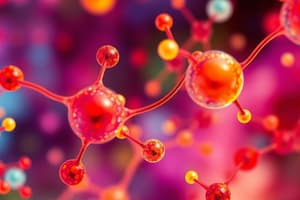Podcast
Questions and Answers
What is the primary function of PCR?
What is the primary function of PCR?
- Detects specific proteins in a sample
- Amplifies specific DNA sequences (correct)
- Separates DNA or protein molecules based on size and charge
- Determines the order of nucleotide bases in a DNA molecule
Which type of microscopy uses a laser light to create high-resolution 3D images?
Which type of microscopy uses a laser light to create high-resolution 3D images?
- Electron Microscopy
- Fluorescence Microscopy
- Confocal Microscopy (correct)
- Light Microscopy
What is the main purpose of Western Blot?
What is the main purpose of Western Blot?
- Detects specific proteins in a sample (correct)
- Determines the order of nucleotide bases in a DNA molecule
- Separates DNA or protein molecules based on size and charge
- Amplifies specific DNA sequences
What is the primary function of Centrifugation?
What is the primary function of Centrifugation?
What is the main purpose of Electrophoresis?
What is the main purpose of Electrophoresis?
What is the primary function of RNA Interference (RNAi)?
What is the primary function of RNA Interference (RNAi)?
What is the main purpose of Gene Cloning?
What is the main purpose of Gene Cloning?
What is the primary function of Chromatography?
What is the primary function of Chromatography?
Flashcards are hidden until you start studying
Study Notes
Microscopy
- Light Microscopy: uses visible light to magnify specimens, resolution limited to 0.2-0.3 μm
- Electron Microscopy: uses electron beam to magnify specimens, resolution up to 0.1 nm
- Fluorescence Microscopy: uses fluorescent dyes to visualize specific structures or proteins
- Confocal Microscopy: uses laser light to create high-resolution 3D images
Molecular Biology
- PCR (Polymerase Chain Reaction): amplifies specific DNA sequences
- DNA Sequencing: determines the order of nucleotide bases in a DNA molecule
- Gel Electrophoresis: separates DNA or protein molecules based on size and charge
- Western Blot: detects specific proteins in a sample
- RNA Interference (RNAi): silences specific genes by degrading their mRNA
Cell Culture
- Primary Cell Culture: cells isolated from an organism and grown in vitro
- Cell Line: immortalized cells that can be grown indefinitely
- Cell Transformation: introduction of a foreign gene into a cell
- Cell Transfection: introduction of a foreign gene into a cell using a vector
Biochemistry
- Chromatography: separates and purifies molecules based on their properties
- Spectroscopy: measures the interaction between molecules and electromagnetic radiation
- Electrophoresis: separates molecules based on their size and charge
- Enzyme-Linked Immunosorbent Assay (ELISA): detects specific proteins or antigens
Biotechnology
- Recombinant DNA Technology: combines DNA from different sources to create new genetic combinations
- Gene Cloning: creates multiple copies of a specific gene
- Protein Engineering: designs and modifies proteins for specific functions
- Gene Expression: analysis of gene activity and regulation
Other Techniques
- Centrifugation: separates particles based on their size and density
- Filtration: separates particles based on their size and shape
- Spectrophotometry: measures the absorbance of light by a sample
- Microinjection: introduces substances into cells or embryos
Microscopy
- Light Microscopy: uses visible light to magnify specimens, resolution limited to 0.2-0.3 μm, suitable for observing live cells and tissues
- Electron Microscopy: uses electron beam to magnify specimens, resolution up to 0.1 nm, suitable for observing ultrastructural details
- Fluorescence Microscopy: uses fluorescent dyes to visualize specific structures or proteins, suitable for observing cellular components and protein localization
- Confocal Microscopy: uses laser light to create high-resolution 3D images, suitable for observing tissue morphology and cell-cell interactions
Molecular Biology
- PCR (Polymerase Chain Reaction): amplifies specific DNA sequences, allowing for millions of copies of a target DNA sequence
- DNA Sequencing: determines the order of nucleotide bases in a DNA molecule, allowing for genetic information to be read
- Gel Electrophoresis: separates DNA or protein molecules based on size and charge, allowing for visualization of molecular sizes and structures
- Western Blot: detects specific proteins in a sample, allowing for protein identification and quantification
- RNA Interference (RNAi): silences specific genes by degrading their mRNA, allowing for gene function analysis
Cell Culture
- Primary Cell Culture: cells isolated from an organism and grown in vitro, suitable for studying cell behavior and response to stimuli
- Cell Line: immortalized cells that can be grown indefinitely, suitable for large-scale cellular studies and protein production
- Cell Transformation: introduction of a foreign gene into a cell, allowing for genetic modification and gene expression studies
- Cell Transfection: introduction of a foreign gene into a cell using a vector, allowing for gene expression and regulation studies
Biochemistry
- Chromatography: separates and purifies molecules based on their properties, such as size, charge, and affinity
- Spectroscopy: measures the interaction between molecules and electromagnetic radiation, allowing for molecular structure analysis
- Electrophoresis: separates molecules based on their size and charge, allowing for molecular size and structure analysis
- Enzyme-Linked Immunosorbent Assay (ELISA): detects specific proteins or antigens, allowing for protein quantification and antibody detection
Biotechnology
- Recombinant DNA Technology: combines DNA from different sources to create new genetic combinations, allowing for genetic engineering and gene therapy
- Gene Cloning: creates multiple copies of a specific gene, allowing for large-scale gene expression and protein production
- Protein Engineering: designs and modifies proteins for specific functions, allowing for enzyme optimization and therapeutic protein development
- Gene Expression: analysis of gene activity and regulation, allowing for understanding of gene function and cellular processes
Other Techniques
- Centrifugation: separates particles based on their size and density, allowing for cell fractionation and purification
- Filtration: separates particles based on their size and shape, allowing for sample purification and buffer exchange
- Spectrophotometry: measures the absorbance of light by a sample, allowing for molecular concentration and purity analysis
- Microinjection: introduces substances into cells or embryos, allowing for gene delivery and cellular manipulation
Studying That Suits You
Use AI to generate personalized quizzes and flashcards to suit your learning preferences.




